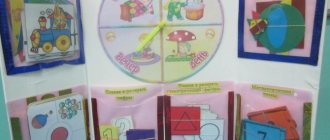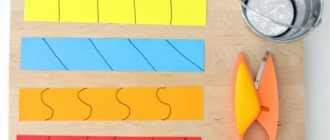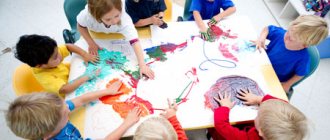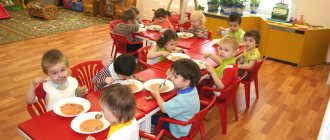Consultation for parents "Fun math at home"
Consultation for parents.
"FUN MATH AT HOME"
Makovskaya Elena Vyacheslavovna
teacher of KSU Secondary School No. 1, Taiynsha North Kazakhstan region, Republic of Kazakhstan
An important place should be given to teaching preschoolers the basics of mathematics. This is caused by a number of reasons (especially nowadays)
: the beginning of schooling, the abundance of information received by the child, increased attention to computerization from preschool age, the desire of parents in this regard to teach the child to recognize numbers, count, and solve problems as early as possible. Adults often rush to give the child a set of ready-made knowledge and judgments, which he absorbs like a sponge, for example, teaching the child to count to 100, to 1000, etc. etc. without mastering complete knowledge within 10. However, does this always give the expected result? For example, should a child be forced to do math if he is bored?
The main effort of both teachers and parents should be aimed at instilling in a preschooler the need to experience an interest in the very process of cognition, in overcoming difficulties, in independently finding solutions. It is important to cultivate and instill an interest in mathematics.
Acquaintance with size, shape, and spatial references begins in a child very early, already from infancy. At every step he is faced with the need to take into account the size and shape of objects, to correctly navigate in space, while for a long time he may not feel, for example, the need to count. Therefore, the knowledge that the child is most predisposed to assimilate is of paramount importance.
At the same time, it is fundamentally important that mathematics enters children’s lives not as a theory, but as an introduction to an interesting new phenomenon in the world around them. Avoid verbalism, formality, and knowledge of the child. The entire learning process should be geared towards the emergence of “why” as early as possible. This is the emergence of interest in the process, in the reason, the first “discoveries”, burning eyes, and the desire to learn “more and more.” Here the motivational basis for further personal development is laid, cognitive interest and the desire to learn something new are formed.
Any mathematical problem involving ingenuity carries a certain mental load and develops in children cognitive interest and the ability for research and creative search.
Introducing children of senior preschool age in a family setting to entertaining mathematical material will help solve a number of pedagogical problems.
It is known that play, as one of the most natural activities of children, promotes self-expression, development of intelligence, and independence. This educational function is fully characteristic of entertaining mathematical games.
The desire to achieve a goal - to create a figure, a model, to give an answer; to get a result - stimulates activity, the manifestation of moral and volitional efforts (overcoming difficulties that arise during the decision, bringing the work started to completion, searching for an answer until the result is obtained).
A child should gain his knowledge of mathematics not only from mathematics classes at school, but also from his daily life, from observations of the phenomena of the world around him. Here, you, the child’s parents, come first. Here your help is invaluable, the help of parents who want to contribute to the development and upbringing of their own child. A joint search for solutions to problems helps organize education for children and adults, which not only contributes to better mastery of mathematics, but also enriches the spiritual world of the child, establishes connections between elders and younger ones, which they need in the future to solve life problems.
I want to remind moms and dads, grandparents, that forced education is useless and even harmful. Completing tasks should begin with the sentence: “Shall we play?”
Donate a little of your time and not necessarily free time to your child, on the way to kindergarten or home, in the kitchen, on a walk and even in the store, when you are getting dressed for a walk, etc. etc. After all, the FEMP program for kindergartens highlights the main topics “Quantity and Counting”, “Size”, “Form”, “Orientation in Space and Time”. Agree, you can pay attention to all these concepts in everyday life.
Draw children's attention to the shape of various objects in the world around them and their quantity. For example, the plates are round, the tablecloth is square, the clock is round, ask what shape this or that object resembles. Choose an object similar in shape to this or that figure. Ask what they have two: two arms, two legs, two ears, two eyes, two feet, two elbows, let the child show them. And what one thing at a time.
Entertaining games contribute to the formation and development of such personality qualities as focus and perseverance.
Practice counting at home with your child in the game “Who is the Biggest?”
There are two piles of buttons in front of the players, or you can take beads. On command, players put away one button or bead from the pile within a minute; Then they count who saved the most. You can complicate the game: put down buttons with your eyes closed, etc.
Carrying out practical activities using entertaining material develops in children the ability to perceive cognitive tasks and find new ways to solve them.
For the game “How much is in the other hand?” Prepare small items (beads). Rules of the game: an adult says: “I have 6 beads, in my right hand there are 3 beads (shows). How much is in the left?” If the child guesses correctly, switch roles (when you guess, make intentional mistakes).
“ with you .
Place cards with numbers from 0 to 10 on the table. The child closes his eyes, and at this moment you remove one of the cards so that you get a continuous row; if the child gives the correct answer, then change roles with him. Entertaining games contribute to the formation and development of such personality qualities as focus and perseverance. In didactic games, children are attracted by the unusual setting of the problem (guess, find, etc.) and the way it is presented (help Dunno determine who his neighbors are, etc.). Any didactic game solves a specific problem aimed at improving children’s mathematical (quantitative, temporal, spatial) concepts.
On the way to school or home, look at the trees (higher, lower, thicker, thinner)
.
Your child draws. Ask him about the length of the pencils, compare them in length, so that the child in life, in everyday life, uses words such as long-short, wide-narrow (scarves, towels, for example)
, high-low
(wardrobe, table, chair, sofa)
;
thicker or thinner (sausage, frankfurter, stick)
.
Use toys of different sizes (nesting dolls, dolls, cars)
, different lengths and thicknesses, sticks, pencils, pieces of rope, thread, strips of paper, ribbons... It is important that these words are in the vocabulary of children, otherwise more and more, before school, they use big -small. The child must use the correct words for comparison by size by school.
While reading books, draw children's attention to the characteristic features of animals (a hare has long ears, a short tail; a cow has four legs; a goat has fewer antlers than a deer)
. Compare everything around by size.
Children become familiar with numbers. Pay attention to the numbers that surround us in everyday life, in various situations, for example, on a dial, in a calendar, in an advertising newspaper, on a telephone, a page in a book, the number of your house, apartment, car number.
Invite your child to look at the numbers on the phone with you, call them first in forward order, and then in reverse order, say your phone number; ask if the number has the same numbers. Ask to count as many items (any)
, how many the number shows, or show that number, how many items there are
(how many buttons you have on your blouse)
.
While preparing lunch, ask your child where there is more water: in a cup, in a pan, in a kettle, in a plate? He can verify the correctness of the answer in practice. Be sure to clarify what you measured with and how many conventional measurements were in each of the vessels.
Children begin to realize that each of the entertaining tasks contains some kind of trick. It is impossible to find it without concentration and thought. Give children problems in poetic form:
Four goslings and two ducklings are swimming in the lake and screaming loudly. Well, quickly count, How many babies are there in the water? (Six) Seven cheerful piglets stand in a row at the trough. Two went to bed to go to bed - How many pigs are there in the trough? (Five) Natasha has five flowers and Sasha gave her two more. Who here can count, What is two and five? (Seven)
"Tangram" is one of the simplest games. They also call it “Cardboard Puzzle” and “Geometric Constructor”. A square measuring 8 by 8 cm made of cardboard, equally colored on both sides, is cut into 7 parts. The result is 2 large, 1 medium and 2 small triangles, a square and a parallelogram. Using all 7 parts, tightly attaching them to one another, you can create many different images using samples or your own design.
-A more complex activity that is interesting for children is recreating figures based on contour patterns. Recreating figures using contour patterns requires visual division of the shape of a particular planar figure into its component parts, i.e. on the geometric figures from which it is composed.
I suggest trying to play the game “Tangram”. But first a riddle:
Long neck,
Red paws,
Pinches your heels
Run without looking back.
"Goose"
.
During the game, children's ability to visually analyze a sample is improved. Search actions aimed at choosing the method of spatial arrangement of figures based on visual analysis become purposeful. Children begin to justify their actions and plans.
Exciting game "Columbus Egg".
The mathematical construction game “Columbus Egg” is intended for children 3-8 years old. Oval of 10 parts: among them 4 triangles (2 large and 2 small), 2 figures similar to a quadrangle, one of the sides of which is round, 4 figures (large and small), resembling a triangle, but with one side rounded... You can play it by making funny figures of all kinds of objects, birds and animals from parts of Columbus's Egg.
In this case, you need to adhere to simple rules.
1. The parts of the constructor must be connected in such a way that they do not overlap each other. 2. All parts of the constructor must be used in the assembled figure.
"Mongolian game"
The puzzle is a square cut into 11 pieces: 2 squares, one large rectangle, 4 small rectangles, 4 triangles.
Game task: Collect all kinds of figures from these elements according to the principle of a mosaic.
Mastering the game requires certain skills from the child, so it is recommended to teach children the game in the following sequence:
1. Introduce children to the game, tell about the history of the game’s origin, consider all the details, sample images.
2.Make geometric shapes based on the contour pattern. Each figurine must include all eleven parts, and they must not overlap.
3.Create your own figures using the same principle.
4.For children. Collect geometric shapes.
Geometric puzzles are the simplest of their class of logic games. As your child gets older, you can acquire more complex logic games.
Play with your children. Develop children's creative abilities, independence, and come up with new options for silhouette figures.
MAGAZINE Preschooler.RF
Consultation for educators on the topic: “Mathematics is an interesting country”(from work experience)
Completed by: teacher of MBDOU kindergarten No. 244 Belskaya N.V. Municipal budgetary preschool educational institution kindergarten No. 244 of a general developmental type in the Sovetsky district of the city of Ufa of the Republic of Bashkortostan
Our mathematics flies above the stars, goes out into the seas, builds buildings, plows, plants trees, forges turbines, reaches out to the very sky.
Yu.Yakovlev
“Mathematics continues to be the most time-consuming subject in school ,” teachers, parents, and students themselves say this. What about preschoolers? They don't know that mathematics is a difficult discipline, and they should never know about it.
Modern mathematical development of preschoolers is no longer considered as a complex methodological direction that implements the main task - preparing children for further education at school.
The main thing is to introduce children to the world of logic, i.e. to teach thinking, reasoning, guessing, analyzing, comprehending mathematical concepts, promoting interest in mathematics and self-confidence - this is the true purpose of the essence of mathematical development of preschoolers at the present stage. Revealing the wonderful world of surrounding numbers and figures, mathematics teaches children to think more clearly and consistently, develops the brain and attention, fosters perseverance and will, and teaches children to acquire knowledge. “Mathematics must then be taught so that it puts the mind in order” M.V. Lomonosov. The serious content of mathematical development can be absorbed by modern children if it gives them pleasure. Therefore, a significant role is played by the form of presentation, which evokes emotional coloring, ease, interest, and cognitive interest, which develops into the cognitive activity of the child. “You can only learn through fun... To digest knowledge, you need to absorb it with appetite” A. France. During mathematics classes, the children and I go to the amazing, fabulous Kingdom of Mathematics , travel around the islands, discover new countries. Here we are helped by a wide variety of didactic games ( "Geometric Lotto" , "Decorate the Mat" , "Logic Tables" ), games with words ( "Who knows - let him count further" , "Name the next day of the week" , "What is round..." ), games with geometric material ( “Columbus Egg” , “Tangram” , “Mongolian Game” , “Magic Circle” ), puzzle games, logical problems, proverbs, sayings, catchphrases, funny poems about numbers (S. Marshak, Z.Alexandrova, P.Bashmakov, V.Stepanov, V.Bakaldin), problems in verse, riddles, counting rhymes. Children love games with counting sticks. With the help of sticks they create not only familiar objects, but also fantasize about something unusual and original. Our parents helped us design a math mat (numbers on one side, geometric shapes on the other). On a magic math mat, we go on a journey to the forest, to the city of mathematical riddles, to the world of numbers. To visit Dunno. To consolidate knowledge about the sequence of days of the week, we made the “Seven-Flower Flower” , the “Collect a Day” , and pencil cases with geometric shapes for counting activities.
We consolidate knowledge in mathematics not only in FEMP classes, but also in other types of educational activities. So, in art classes, children depict objects similar to one or another geometric figure ( “Houses of the Three Little Pigs” , “Snow Family” , “Ribbon Decoration” ), in sculpting, children sculpt large and small balls, carrots, vegetables, fruits, They create geometric patterns on the appliqué, cut out a circle from a square, an oval from a rectangle ( “Teddy Bear” , “Tumbler” , “Building a House” ). In classes on familiarization with fiction, we read fairy tales by M.I. Stozharova. The attractive plot of fairy tales can be used for didactic purposes, connecting fairy-tale twists and turns and problem-cognitive situations. Here children learn to reason, think logically, and justify their chosen solution options. So, in “The Tale of How a Circle and a Square Went on a Hiking Tour ,” children select objects similar to one or another geometric figure; in the fairy tale “The Apple,” children divide a circle into two and four equal parts.
One of the types of educational activities are mathematical competitions, holidays, entertainment, quizzes (the “Catch-Up” , the “Granny Tricky” “Teremok” entertainment ). They require from participants not only knowledge, but also resourcefulness and ingenuity, and arouse genuine interest in children of all ages.
On a walk with children, we count leaves, pebbles, cones ( “Arrange leaves of different sizes” ), compare houses, trees, and draw with sticks on the wet sand on the theme “Funny Picture .
A lot of work is being done with parents. We invite parents to open classes on FEMP ( “Pinocchio is visiting us” , “1,2, 3, 4, 5 - we learned to count” , “An amazing trip to the country of Chisland” ), we conduct joint entertainment competitions ( “Competition sellers” , “Come on, little star, light up!” , “Mathematical Quiz” ), open house evening “Mathematical Toy Library” (joint games of children and parents using didactic games), introduced the tradition of the group “Weekend Game!” (children, if they wish, take one game home for the day off), we add information to the stand ( "Learn by playing" , "Country of Mathematics" , "Cultivate the joy of learning" , "Play with us" ).
Traveling through the fairy-tale country “Mathematics” , our children learn about the world around them, show their ingenuity, attention, courage, imagination, flexibility of mind. And we believe that upon entering first grade, our little person will retain within himself a spark of inquisitiveness and curiosity, a thirst for new discoveries!
| Next > |






